Delivery drones are revolutionizing logistics with their varying load capacities, which can range from a few kilograms to over 100 kilograms, allowing for the transport of diverse goods. Their operational range typically spans from a few kilometers to over 100 kilometers, enabling efficient deliveries across different distances. By leveraging these capabilities, delivery drones can significantly reduce delivery times compared to traditional methods, making them an increasingly viable option for modern shipping needs.
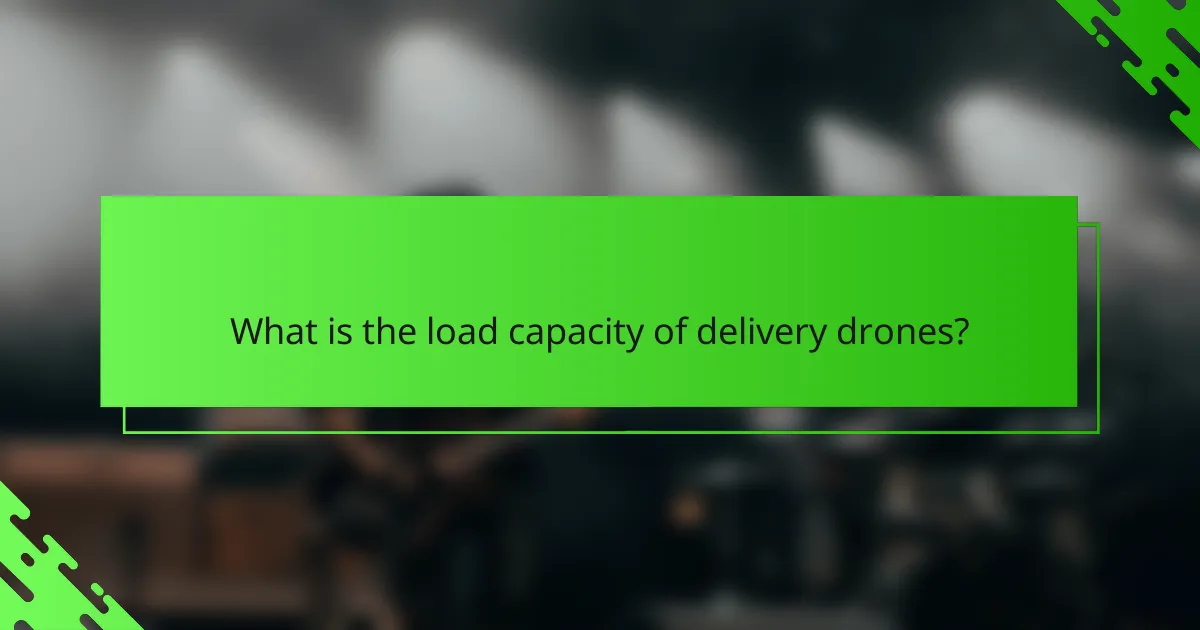
What is the load capacity of delivery drones?
The load capacity of delivery drones varies significantly based on their design and intended use, typically ranging from a few kilograms to over 100 kilograms. This capacity directly impacts the types of goods that can be transported and the operational efficiency of the drone.
Typical load capacity ranges
Most consumer delivery drones can carry loads between 1 to 5 kilograms, suitable for small packages like food or documents. Commercial drones, designed for larger deliveries, often have capacities ranging from 10 to 50 kilograms, allowing them to transport heavier items such as medical supplies or e-commerce products.
High-capacity drones, used in specialized applications, can exceed 100 kilograms. These drones are typically employed in industries like agriculture or logistics, where transporting bulk materials is essential.
Examples of high-capacity drones
One notable example is the DJI Matrice 600, which can carry up to 6 kilograms, making it ideal for aerial photography and light cargo delivery. Another example is the Wingcopter, capable of transporting loads up to 10 kilograms over long distances, often used in medical supply deliveries.
For heavier applications, the Griffon 4000 can handle payloads exceeding 100 kilograms, primarily used in military and industrial contexts. These drones demonstrate the versatility and scalability of drone technology in meeting diverse delivery needs.
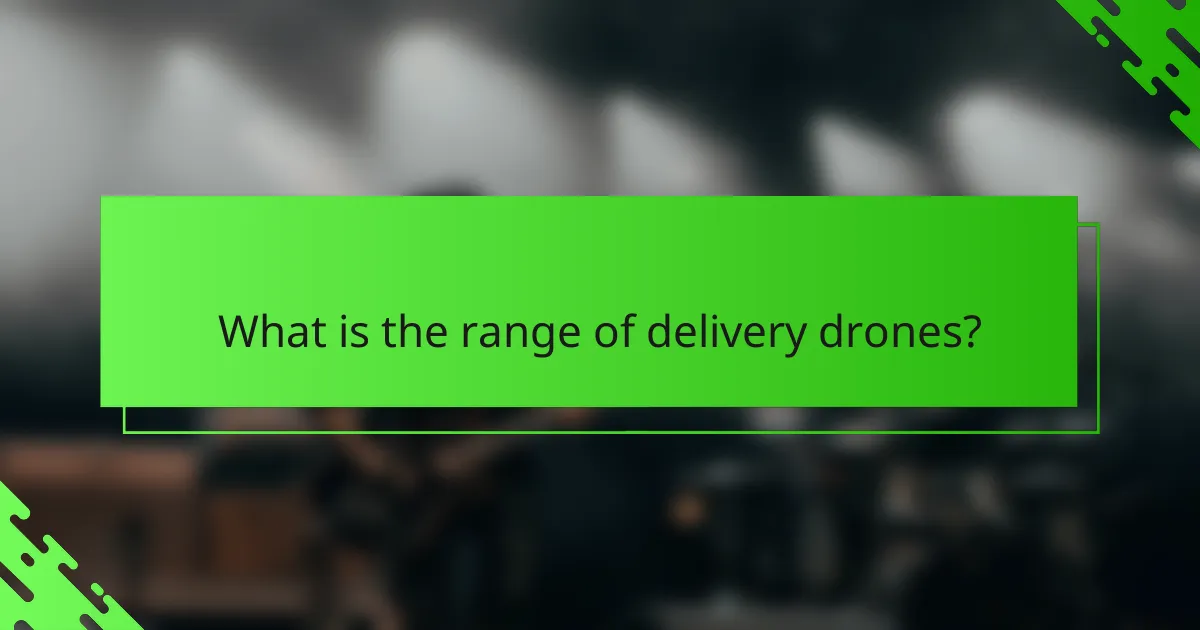
What is the range of delivery drones?
The range of delivery drones typically varies from a few kilometers to over 100 kilometers, depending on the model and its specifications. This range determines how far a drone can travel to deliver packages efficiently.
Average operational range
Most commercial delivery drones operate within a range of 10 to 30 kilometers for standard deliveries. High-end models designed for longer distances can achieve ranges exceeding 100 kilometers, making them suitable for rural or less accessible areas.
For example, a drone with a 20-kilometer range can effectively serve urban environments, while a model with a 50-kilometer range may be ideal for suburban or rural deliveries.
Factors affecting drone range
Several factors influence the operational range of delivery drones, including battery life, payload weight, and environmental conditions. Heavier payloads can significantly reduce the distance a drone can travel, as more energy is required for lift and navigation.
Additionally, weather conditions such as wind speed and temperature can impact performance. For instance, strong winds may require more power to maintain stability, thus reducing the effective range.
Lastly, regulatory restrictions may limit the operational range in certain areas, as drones must adhere to local aviation laws and airspace regulations.
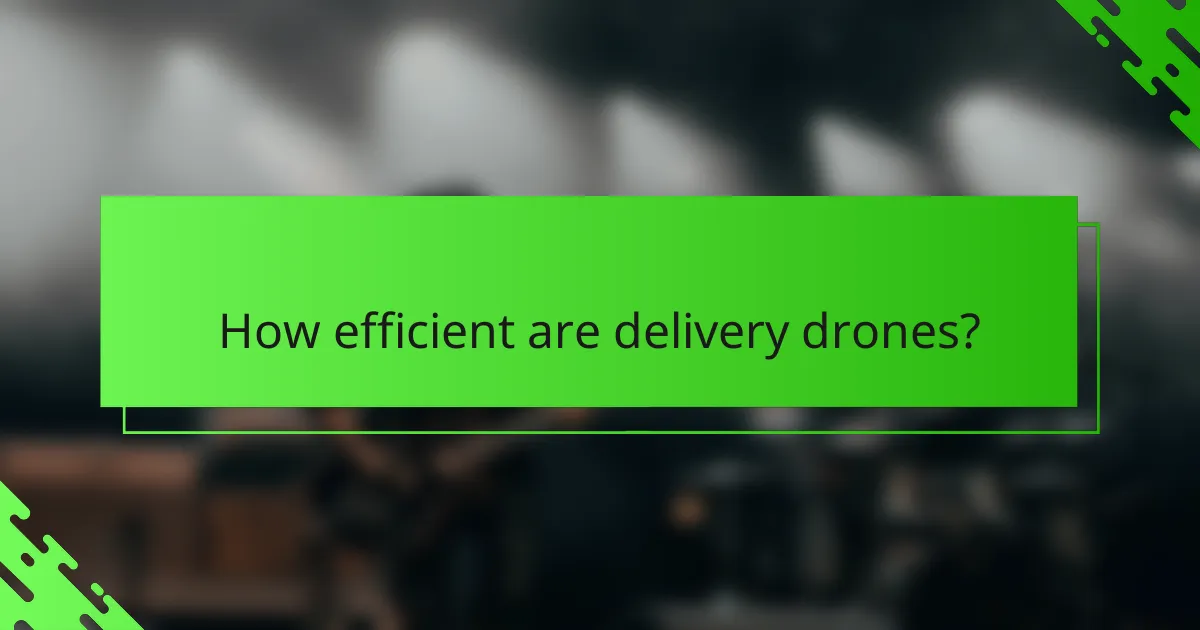
How efficient are delivery drones?
Delivery drones are highly efficient for transporting goods over short to medium distances, often completing deliveries in a fraction of the time compared to traditional methods. Their efficiency is influenced by factors such as load capacity, range, and operational costs.
Efficiency metrics
Efficiency metrics for delivery drones typically include load capacity, range, speed, and energy consumption. Load capacity refers to the maximum weight a drone can carry, usually ranging from a few kilograms to around 10 kg for commercial models. Range indicates how far a drone can travel on a single charge, often between 10 to 30 kilometers.
Speed is another critical metric, with many delivery drones capable of flying at speeds of 40 to 80 km/h. Energy consumption is measured in terms of battery usage per kilometer, which can vary significantly based on the drone’s design and payload.
Comparative efficiency of models
When comparing the efficiency of different delivery drone models, consider their specifications and intended use cases. For instance, lightweight drones designed for urban deliveries may prioritize speed and maneuverability, while heavier models may focus on load capacity for rural or industrial applications.
Some popular models include the DJI Matrice series, known for its versatility and payload capacity, and the Zipline drones, which excel in medical supply deliveries with longer ranges. Evaluating these models based on their efficiency metrics can help businesses choose the right drone for their delivery needs.
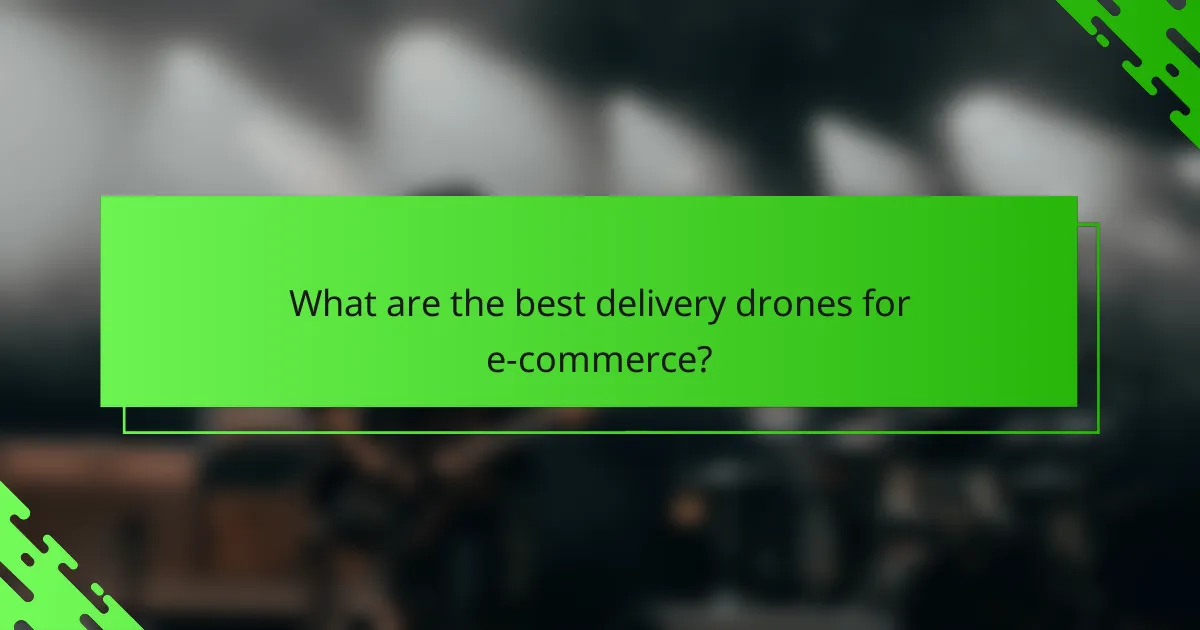
What are the best delivery drones for e-commerce?
The best delivery drones for e-commerce are those that balance load capacity, range, and efficiency. These drones are designed to meet the specific needs of businesses, ensuring timely and cost-effective deliveries.
Top-rated delivery drones
Some of the top-rated delivery drones include the DJI Matrice 300 RTK, Zipline’s drone, and the Wingcopter 198. These models are recognized for their reliability, advanced technology, and ability to handle various payloads efficiently.
For instance, the DJI Matrice 300 RTK can carry a payload of up to 2.7 kg and has a flight time of about 55 minutes, making it suitable for medium-range deliveries. Zipline’s drones are known for their extensive range and have been successfully used in medical supply deliveries across countries.
Specifications for e-commerce needs
When selecting a delivery drone for e-commerce, consider key specifications such as load capacity, range, and battery life. A typical e-commerce drone should have a load capacity of at least 1-5 kg and a range of 10-30 km to effectively serve urban and suburban areas.
Efficiency is crucial; look for drones with quick recharge times and the ability to navigate autonomously. Compliance with local regulations, such as those set by the FAA in the United States or EASA in Europe, is also essential to ensure safe operations.
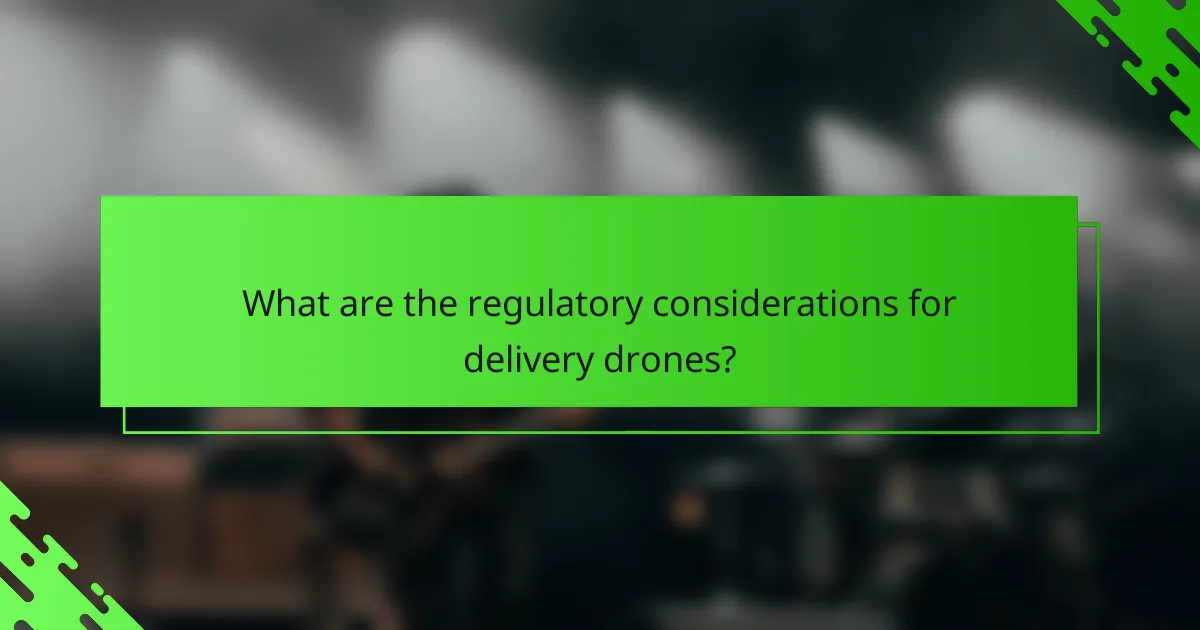
What are the regulatory considerations for delivery drones?
Regulatory considerations for delivery drones include compliance with aviation laws, safety standards, and operational guidelines set by authorities. These regulations vary by country and impact how drones are designed, operated, and integrated into existing airspace systems.
FAA regulations in the US
The Federal Aviation Administration (FAA) governs the use of delivery drones in the United States. Operators must adhere to Part 107 regulations, which cover aspects such as pilot certification, drone registration, and operational limits, including maximum altitude and weight restrictions.
Delivery drones must maintain visual line-of-sight during operations, and flights are generally restricted to daylight hours. Additionally, specific airspace classifications may require special permissions or waivers, particularly in urban areas or near airports.
International regulatory frameworks
Internationally, regulations for delivery drones vary significantly by region. The European Union Aviation Safety Agency (EASA) has established a framework that includes categories for drone operations based on risk, which affects how delivery services can operate across member states.
In other regions, such as Asia and Australia, regulations are evolving to accommodate the growing use of drones for delivery. Operators must stay informed about local laws, which may include restrictions on flight paths, altitude limits, and requirements for remote pilot licensing.
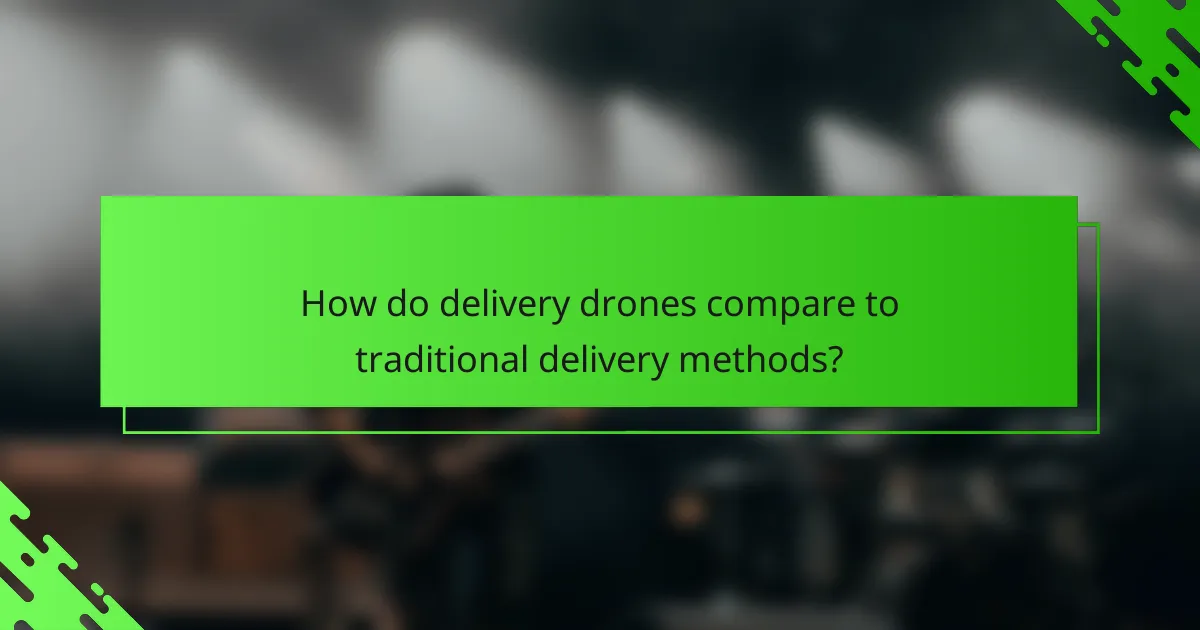
How do delivery drones compare to traditional delivery methods?
Delivery drones offer a modern alternative to traditional delivery methods by providing faster and often more efficient service. They can navigate directly to delivery locations, bypassing traffic and reducing delivery times significantly.
Cost comparison
Delivery drones can reduce operational costs for businesses by minimizing labor and fuel expenses. While the initial investment in drone technology can be high, ongoing costs may be lower compared to traditional delivery vehicles, especially in urban areas where traffic congestion is common.
For instance, the cost per delivery using drones can range from a few dollars to low tens of dollars, depending on the distance and weight of the package. In contrast, traditional delivery methods may incur higher costs due to fuel, maintenance, and driver wages.
Speed and reliability differences
Delivery drones typically offer faster delivery times, often completing deliveries in single-digit minutes for short distances. This speed is particularly beneficial for urgent deliveries, such as medical supplies or food.
Reliability can vary based on weather conditions and regulatory restrictions. Drones may face limitations in adverse weather, while traditional delivery methods can be more consistent in various conditions. However, drones can often deliver to hard-to-reach areas where traditional vehicles may struggle.
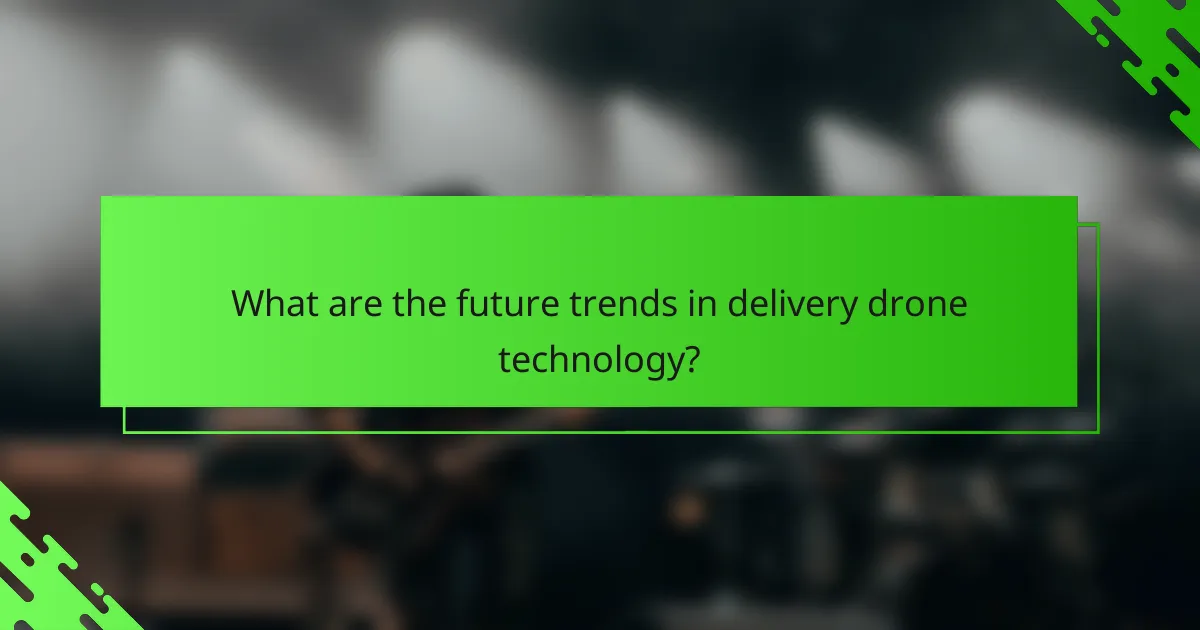
What are the future trends in delivery drone technology?
Future trends in delivery drone technology focus on enhanced load capacity, extended range, and improved efficiency. Innovations in battery technology and autonomous navigation systems are driving these advancements, making drones more viable for commercial use.
Emerging technologies
Emerging technologies in delivery drones include advanced battery systems, such as lithium-sulfur batteries, which offer higher energy density and longer flight times. Additionally, artificial intelligence is being integrated for better route optimization and obstacle avoidance, enhancing the overall reliability of drone deliveries.
Another significant development is the use of hybrid drones that combine electric and fuel-based systems, allowing for greater payloads and longer distances. These innovations are crucial as they address the limitations of current battery-operated models, which often struggle with heavier loads and extensive delivery ranges.
Predicted market growth
The delivery drone market is expected to experience substantial growth in the coming years, with estimates suggesting a compound annual growth rate (CAGR) in the high double digits. Factors driving this growth include increasing demand for fast delivery services and advancements in drone technology that improve operational efficiency.
Regions such as North America and Europe are leading the charge, supported by favorable regulations and significant investments in drone infrastructure. As companies continue to explore drone solutions for last-mile delivery, the market is likely to expand, potentially reaching billions in revenue within the next decade.
